
By Becky Killian, Staff Writer
The waterline replacement project along South Main will continue with most of the cost being covered by a grant.
The announcement was made during the Monday, Feb. 10, meeting of the Salem Board of Public Works and Safety and Common Council.
The hardship grant from the Indiana Department of Transportation will cover most of the cost to replace waterlines from the south gate of the square to the bridge over the West Fork Blue River.
The Board of Works approved the low bid of $943,454 from Temple and Temple for the project.
The city will pay 10 percent of the cost with existing funds from its operating budget.
“I think we all agree that investment in our infrastructure is key,” Mayor Justin Green said.
The first phase of the project saw the replacement of waterlines from the traffic light at State Road 56 to the south gate of the square. That project was paid with federal funds.
In other business:
• E&K Lawncare was approved as the low bidder for mowing as well as debris and vegetation removal for both city-owned properties as well as properties in violation of city code. The contractor will be paid $1,095 weekly to mow city owned properties such as around the water plants at Lake Salinda and Lake John Hay. The maintenance of properties in violation of city code will be $80 for mowing a lot and hourly fees for larger lots or those containing debris that must be removed.
• Mosier Family Chiropractic requested the closure of the portion of Market Street between the addresses of 301 and 304 beginning at 4 p.m. for their annual Brick Street Festival, which will be held from 5 to 8 p.m. Saturday, June 7. About 20 vendors are expected, including food trucks.
• Blevins Sanitation requested a two-year contract extension for the city’s waste removal. The contract, which was set to expire in September 2026, will now continue to September 2028. The contract extension was approved by the Board of Works.

Troopers from Indiana State Police Sellersburg Post 45 made multiple arrests after initially serving an outstanding warrant on a Pekin woman.
Late Wednesday, Trooper Kyle Taylor gained information that 53-year-old Edna Murphy was wanted for a probation violation related to possession of methamphetamine. Trooper Taylor also learned Murphy was staying at an address off SR 60 just south of Pekin near the Clark County line.
When officers arrived, they located Murphy but also observed indicators that led them to apply for a search warrant for the premises.
As a result of the search, the investigation continued into the early morning hours of Thursday, and troopers located over 20 grams of suspected methamphetamine and ultimately arrested five individuals located at the address. The names and charges of all arrested are listed below:
- Enda Murphy, 53, Pekin: Initial warrant, Dealing Methamphetamine (Level 4 Felony), Possession of Methamphetamine (Level 6 Felony), Possession of Marijuana (B Misdemeanor), Possession of Paraphernalia (A Misdemeanor).
- Michael Roach, 53, Pekin: Dealing Methamphetamine (Level 2 Felony), Possession of Methamphetamine (Level 4 Felony), Possession of a Syringe (Level 6 Felony), Possession of Paraphernalia (A Misdemeanor).
- Christopher Thomas, 52, Pekin: Dealing Methamphetamine (Level 4 Felony), Possession of Methamphetamine (Level 6 Felony), Possession of Marijuana (B Misdemeanor), Possession of Paraphernalia (A Misdemeanor).
- Kawlija Starrett, 44, Pekin: Possession of Methamphetamine (Level 6 Felony), Possession of Paraphernalia (A Misdemeanor), Possession of Syringe (Level 6 Felony).
- Nicole Starrett, 49, Pekin: Possession of Methamphetamine (Level 6 Felony), Possession of Paraphernalia (A Misdemeanor)
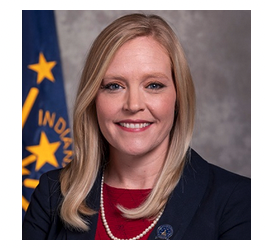
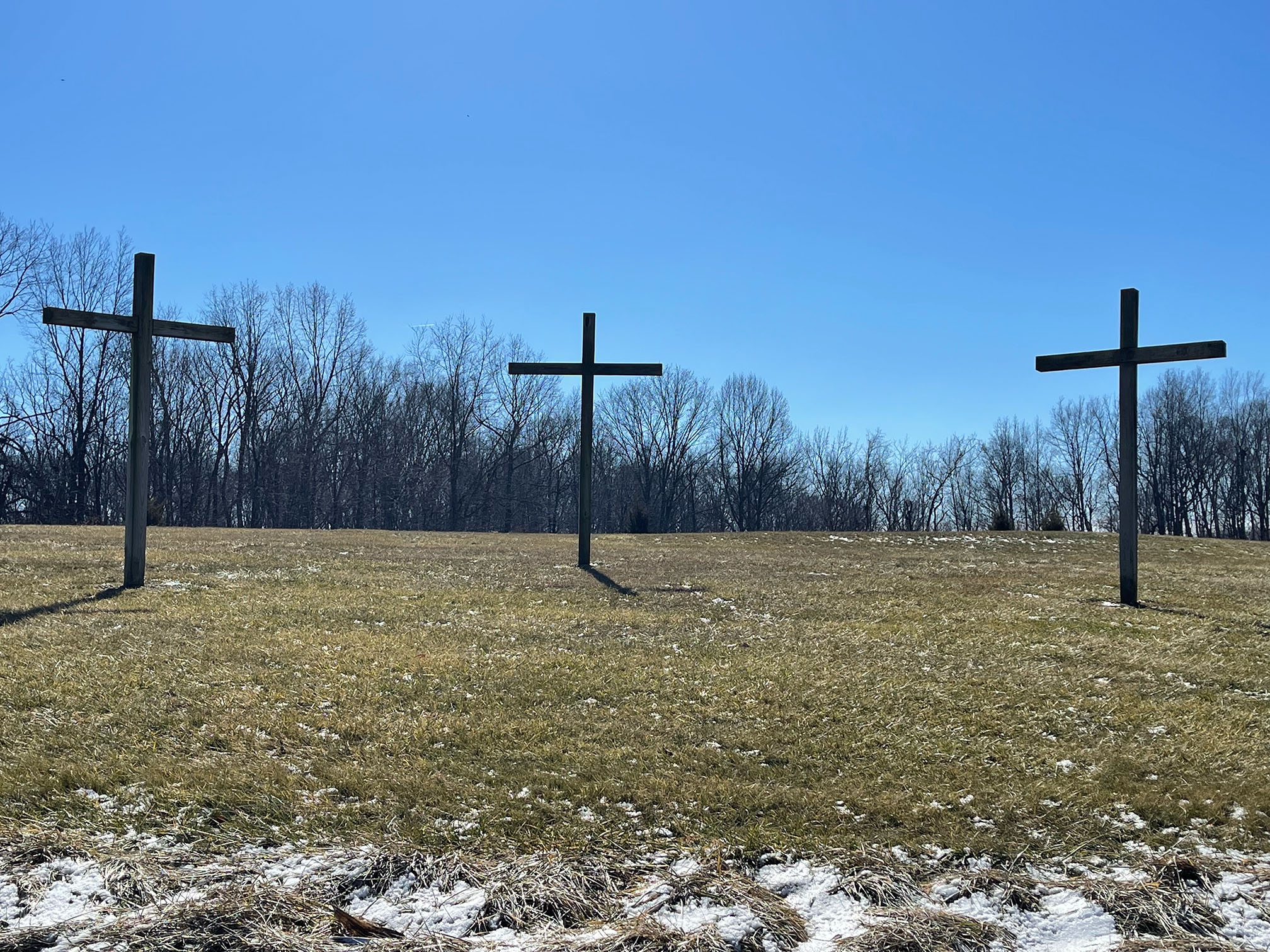
Take a look at this week's Mystery Photo. Think you know where it is? Let us know and be entered into a drawing for the chance to win a prize!
Submissions will be accepted until Monday, February 24. Only correct submissions will be placed in the drawing.
You can submit your answer by:
Email:
Phone: (812) 883-3281
Facebook: Salem Leader Facebook Page
Mail or In-Person: 117 E Walnut St, P.O. Box 506, Salem, IN
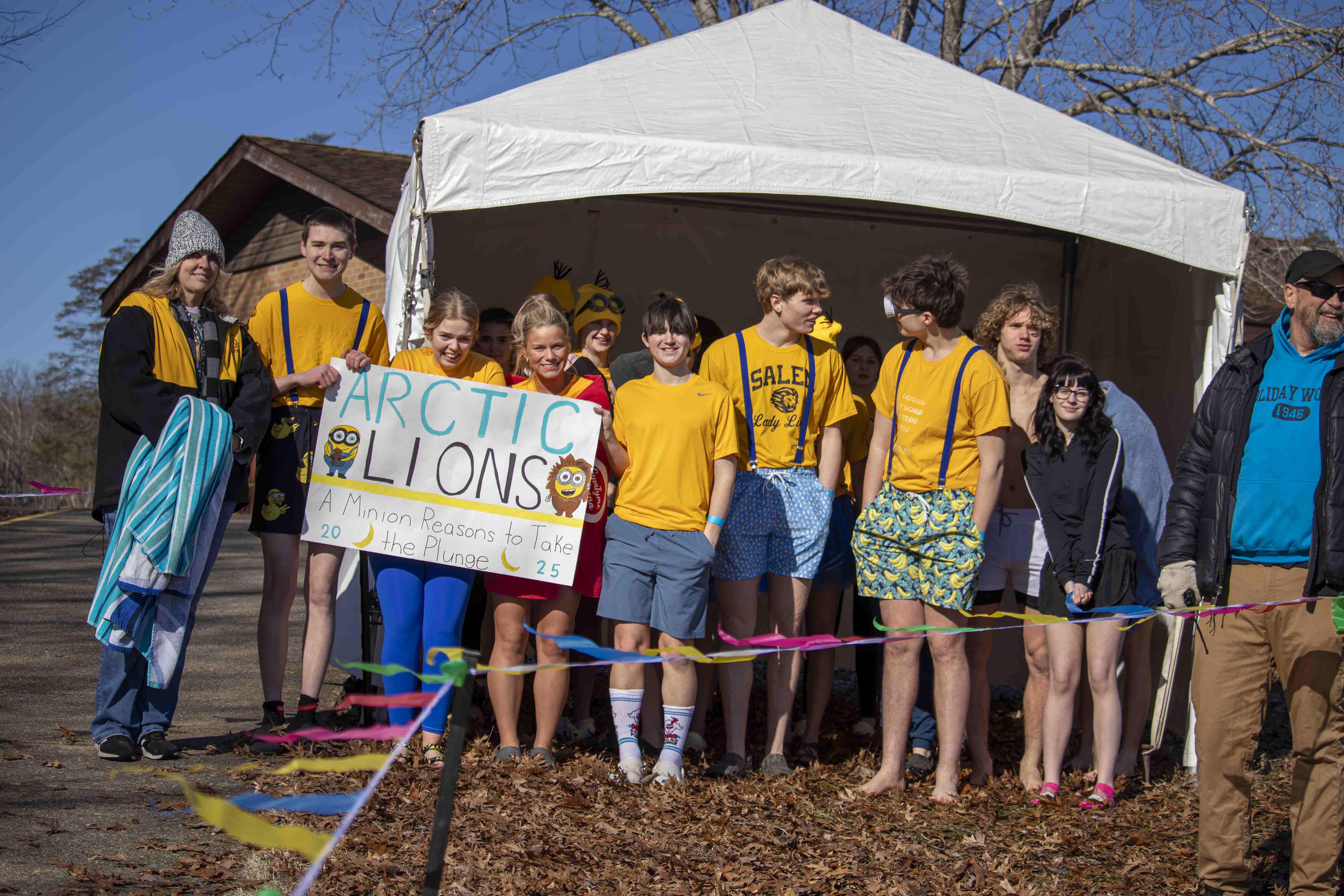
By Nathaniel Smith, Editor
The 2025 high school Polar Plunge commenced this morning, Friday, February 14 at 10:30 a.m., and it was a massive success! With a bone-chilling temperature of 26°F, the event sent 132 plungers from several different schools in our area deep into Deam Lake in Borden to raise funds for Special Olympics. In total, the participating schools raised more than $17,000 for the program. With fundraising like that, the Special Olympics will be able to continue thriving.
I spoke with Craig Tornquist who leads all of the school assemblies for Champions Together. Champions Together is the partnership between the Indiana High School Athletic Association (IHSAA) and Special Olympics.
“It’s a partnership, and it’s all about unified sports,” said Tornquist. “Unified sports are taking students with intellectual disabilities and students without intellectual disabilities and putting them together on the same team. So now, students with intellectual disabilities can compete for a high school state championship, and it’s the same as you’d win in traditional championships. It’s identical. It’s truly amazing, and we now have more than 300 high schools in Indiana doing something with Champions Together.”
Tornquist then went on to discuss the overwhelming support shown throughout the student population.
“These are the coolest high school students anywhere. The best thing about Special Olympics is that everyone is in it for the right reason. There is no one out here today for the wrong reason,” said Tornquist. “I am just really impressed by these young people, and they give me hope.”
Craig Tornquist was not the only one brimming with hope. Angela Phipps leads the Lions Unified group at Salem High School. I spoke with her and discussed the joy and compassion that the students bring to the table. Not only at the Polar Plunge, but at every Lions Unified event.
“Salem has been doing the Plunge since 2016, and I’m just really proud of the kids. They go above and beyond every year,” said Phipps.
Salem also happened to take home a trophy this morning. Due to their loud and proud attitude and enthusiasm, they were awarded with the Team Spirit Award!
Enjoy photos from the high school Polar Plunge below!

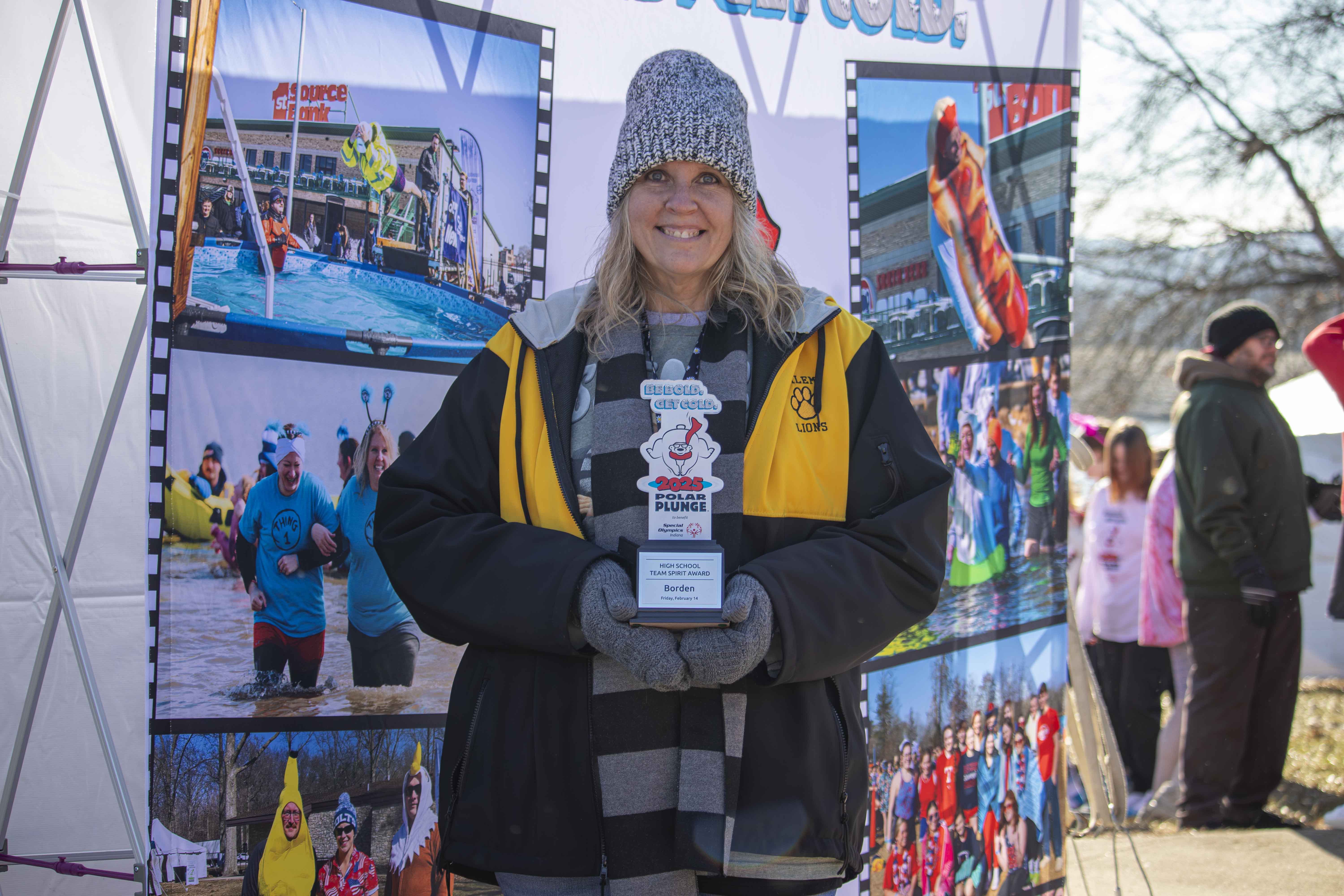 Angela Phipps with Salem's Team Spirit Award.
Angela Phipps with Salem's Team Spirit Award.
 Craig Tornquist.
Craig Tornquist.
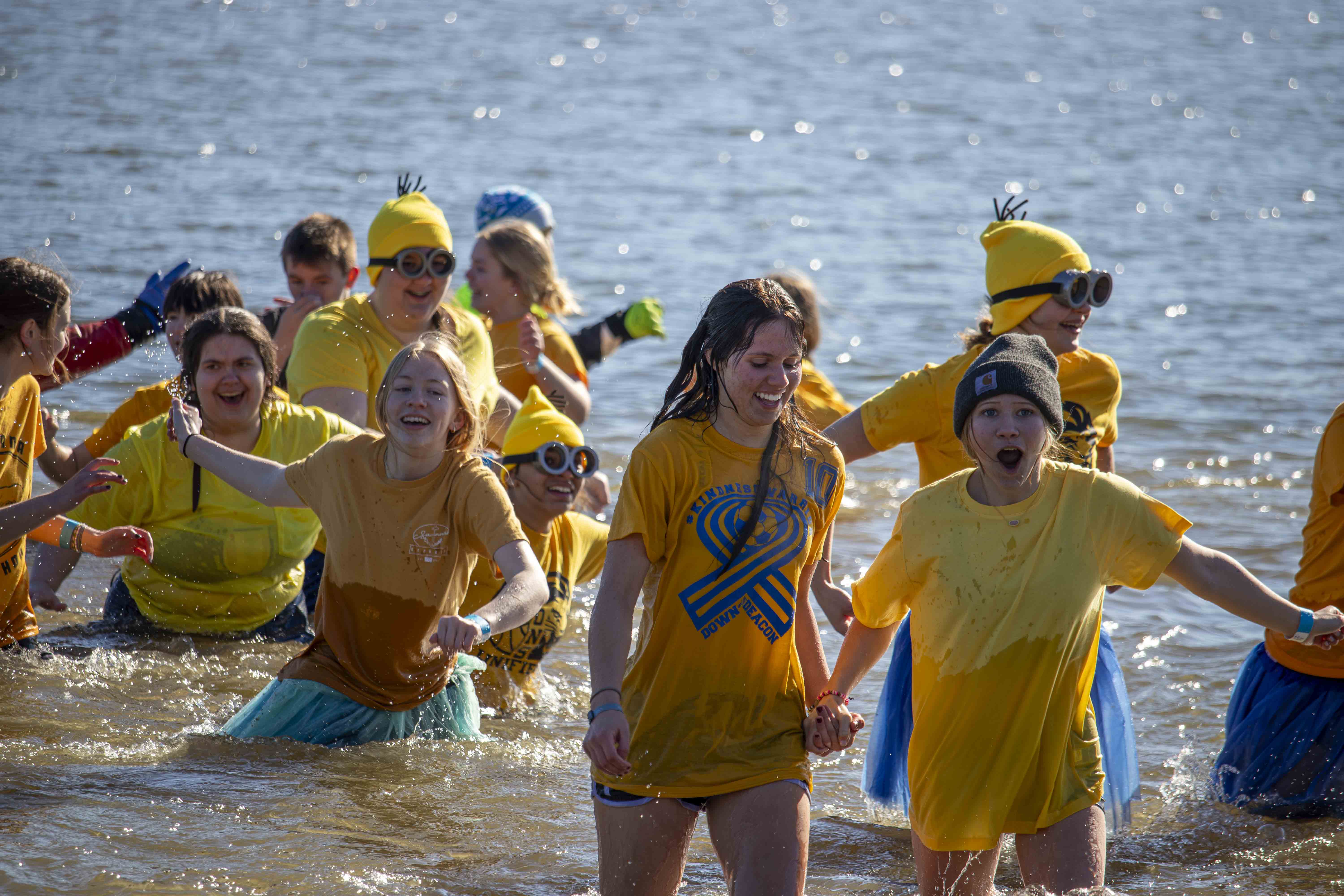





 Emergency Responders ensuring everyone's safety.
Emergency Responders ensuring everyone's safety.
Photos by Nathaniel Smith.
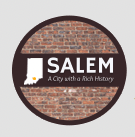
By Becky Killian, Staff Writer
Salem’s utility customers could see water and sewer rate increases over the next three years.
The rate increases received preliminary approval during the Monday, Feb. 10, meeting of the Salem Board of Public Works and Safety and the Common Council.
No rate increases will take effect until after a public hearing, which will be held at 5 p.m. Monday, Feb. 24. Following the hearing, another vote will be held that will either approve or halt the rate increases.
The current monthly water bill for utility customers who use the average of 4,000 gallons a month is $35. That rate would increase by $7 in 2025; $3 in 2026; and $3 in 2027.
A report provided by Baker Tilly Municipal Advisors indicated the rate increase is needed to pay for the utility’s operation and maintenance costs, which have increased by more than 50 percent. The utility also needs additional funds to build and maintain a required cash balance as well as fund capital projects.
The Board of Works unanimously recommended the proposed rate increases to the Council. The Council vote was four to one, with Councilman Roger Pennington voting against the increase.
The current monthly bill for sewer customers who use the average of 4,000 gallons a month is $40 monthly. That would increase to $47 in 2025; to $55 in 2026; and to $57 in 2027.
The reasons given for the sewer rate increases also include covering maintenance costs; to maintain a required cash reserve; to fund capital improvements; to refinance an existing debt used to upgrade the sewer plant; and to pay for a $7.6 million bond for more improvements that have been mandated by the Indiana Department of Environmental Management.
The project will include the replacement of undersized pipes and lift station rehabilitation. The $7.6 million bond is from the Indiana Finance Authority and will have an interest rate of 2.11 percent.
The sewer rate increases received preliminary approval from the Board of Works and the Council in unanimous votes.
When asked why he opposed the water rate increase, Pennington said, “I understand the hardships local residents are feeling right now with the cost of everyday life. It is my responsibility as their councilmen to look for ways to address needed water infrastructure updates without passing on the cost to our residents. Like our President, I believe we have not done our due diligence to cut spending and reduce fraud, waste and abuse. The results of the Water Task Force that I led last year, found significant waste and recommended several cost-cutting measures that were ignored. I cannot support any increase to the cost of living for our residents until, we as a city government have reduced our wasteful spending and maximized every other resource available to us.”
Pennington proposed the formation of the Task Force last March. It included three citizen members and two council members. The stated purpose of the Task Force was to restore confidence in the city’s water utility; however, after months of study, the three citizen members of “Task Force Clean Water” delivered their final report to Salem officials only to have it countered with a separate report by the two elected officials who served alongside them: Pennington and Dylan Moore.
The citizen members were Tom Jacobs, Becky Dewees, and Jason Cockerill.
The citizen members reported that they didn’t find any “gross waste or mismanagement.” They also pointed out that state law requires that utilities collect sufficient rates to maintain the utilities.
Pennington and Moore questioned whether the water utility was in dire financial condition, criticizing how much the city pays for chemicals, sludge hauling, and engineering fees.
At the Feb. 10 meeting, Moore was among the four council members who voted in support of the proposed water rate increases.

Indiana Attorney General Todd Rokita worked with the Federal Bureau of Investigation to take down a Southside Indy-based serial fraudster, James Henley, and secured an order for him to pay back nearly $2 million in restitution. Henley has been sentenced to ten years in federal prison, followed by three years of supervised release after pleading guilty to aggravated identity theft, conspiracy to commit access device fraud, two counts of money laundering, and eight counts of wire fraud. Henley has also been ordered to pay $1,887,426.63 in restitution.
Henley reportedly told federal agents, who worked alongside Indiana’s Homeowner Protection Unit, he was inspired in part to commit mass fraud after watching a crime TV show.
"Our attorneys and federal investigators made sure this man was prosecuted for these flagrant and insidious criminal acts against regular Hoosiers,” Indiana Attorney General Todd Rokita said. "I'm certainly proud of everyone who works in our own Homeowner Protection Unit for their role in helping bring this blatant perpetrator of fraud and theft to justice. We will continue holding accountable all those who aim to enrich themselves by illegally deceiving and exploiting innocent victims."
As part of his fraud schemes, Henley registered five fake businesses (OnTrack Real Estate Solutions, LDI Investments Corp, Lucario Investments, 317 Traffic, and Henley Real Estate Solutions) with the states of Indiana and Kentucky, claiming to serve as the Chief Executive Officer for majority of them – yet none of the businesses were legitimate. Henley used the businesses to mask his identity, make his schemes appear more credible, and launder the stolen money resulting in a total loss of $2,927,758.95 to individual homeowners, an Indiana attorney, a bank, and ten state governments.
Henley’s schemes are broken down as follows:
COVID-19 Fraud:
Between May 2020 and March 2021, James Henley, his wife Jameka Henley, and his associate Jimmie Bickers used the stolen personally identifiable information of 76 real individuals to submit 120 unemployment insurance applications to ten states during the COVID-19 pandemic. Once the applications were approved, the trio used 65 unemployment insurance debit cards to make purchases at retailers and withdraw cash at ATMs in the Evansville and Indianapolis areas. The states paid a total of $1,119,426.63 in unemployment benefits in connection with the group’s fraudulent applications. In July 2020, Henley used funds withdrawn from ATMs to buy a Chevrolet Camaro for $22,801.
Bickers and Jameka Henley have been formally charged for their roles in this scheme but have not pleaded guilty.
Home Title Fraud:
Between December 2021 and May 2023, Henley stole five homes in Indianapolis by filing fraudulent deeds with the Marion County Recorder’s Office. Through the filings, Henley claimed that the homeowners had sold their homes to his fake businesses, but, in reality, he had never even spoken with the homeowners. Unbeknownst to the victims, Henley filed these fraudulent deeds and then sold the homes for significantly less than their market value, pocketing more than $260,000 in profits.
Henley also attempted to steal and sell an additional 14 homes in Indianapolis and Evansville. With one exception, the individuals who bought the homes from Henley took possession and ultimately kept the homes.
For one homeowner, the property Henley stole was her childhood home. She purchased the home while her mother was in the hospital with the hope that, when her mother’s condition improved, her mother would be able to live out her remaining years in the house.
Mortgage Fraud:
In November 2021, an associate of Henley’s purchased a home in Indianapolis, using a mortgage loan from a bank. In April 2022, Henley filed a fraudulent document with the Marion County Recorder’s Office to make it seem as if the mortgage loan had been paid off, when it had not been paid. Henley then filed a deed naming himself a joint owner of the home. Henley and his associate subsequently sold the property for $255,000, pocketing all the proceeds, even though the bank should have received the majority of the funds.
Auto Loan Fraud:
In March 2023, Henley purchased a Dodge Durango in Indianapolis for $71,479, using an auto loan from Everwise Credit Union. A few months later, in June 2023, Henley purchased a Chevrolet Silverado in Plainfield for $54,270, using a second loan from Everwise Credit Union.
In October 2023, Henley connected a JPMorgan Chase bank account to his auto loans, via Everwise’s online payment portal. Henley falsely represented that the Chase account belonged to Jimmie Bickers, and that he had authority to make payments on his loans using funds from the Chase account.
The Chase account was actually an Indiana attorney’s Interest on Lawyers’ Trust Account (IOLTA), which is a highly regulated bank account used by lawyers to hold client funds. The interest earned on IOLTA accounts is used to fund grants for nonprofit groups that promote pro bono and access to justice programs. Henley did not have the attorney’s permission to access or withdraw funds from the IOLTA account.
Between October and November 2023, Henley used the IOLTA account to make two payments, totaling $98,000, toward his auto loans.
Henley has prior felony convictions for financial crimes, including theft, forgery, and fraud.
“I would also like to thank HPU Investigator Lynn Wilkins for her respective role in assisting the FBI in uncovering the deed fraud,” Attorney General Rokita said. “We are lucky to have public servants like her working every day to ensure that our office does everything that we can to protect Hoosiers.”
The Homeowner Protection Unit remains dedicated to protecting the rights of tenants and ensuring equal access to safe housing. This victory underscores the commitment of the Office of the Indiana Attorney General to uphold the law and protect Hoosiers from deceptive practices.
The mission of the Homeowner Protection Unit is to protect the rights of all individuals involved in the housing market, including tenants, homeowners, and aspiring homeowners, by investigating and redressing deceptive acts in connection with mortgage lending and violations of relevant state and federal laws.
Hoosiers with consumer complaints are encouraged to contact the Office of the Attorney General by visiting indianaconsumer.com or calling 1-800-382-5516.

The U.S. Department of Agriculture (USDA) announced the 2025 enrollment periods for key safety-net programs – Agriculture Risk Coverage (ARC) and Price Loss Coverage (PLC) as well as Dairy Margin Coverage (DMC). Agricultural producers can submit applications to USDA’s Farm Service Agency (FSA) for ARC and PLC for the 2025 crop year from Jan. 21 to April 15 and for DMC for the 2025 coverage year from Jan. 29 to March 31.
ARC and PLC provide financial protections to farmers from substantial drops in crop prices or revenues and are vital economic safety nets for most American farms. Meanwhile, DMC provides producers with price support to help offset milk and feed price differences.
“Our safety-net programs provide critical financial protections against commodity market volatilities for many American farmers, so don’t delay enrollment,” said FSA Administrator Zach Ducheneaux. “If you’re getting coverage through the Agriculture Risk Coverage or Price Loss Coverage programs, avoid the rush and contact your local FSA office for an appointment. Even if you are not changing your program election for 2025, you still need to sign a contract to enroll.”
“And at $0.15 per hundredweight for $9.50 coverage, risk protection through Dairy Margin Coverage is a relatively inexpensive investment in a true sense of security and peace of mind.”
The American Relief Act, 2025 extended many Farm Bill-authorized programs for another year, including ARC and PLC as well as DMC.
ARC and PLC
Producers can elect coverage and enroll in ARC-County (ARC-CO) or PLC, which provide crop-by-crop protection, or ARC-Individual (ARC-IC), which protects the entire farm. Although election changes for 2025 are optional, producers must enroll through a signed contract each year. Also, if a producer has a multi-year contract on the farm it will continue for 2025 unless an election change is made.
If producers do not submit their election revision by the April 15 deadline, their election remains the same as their 2024 election for commodities on the farm from the prior year. Farm owners cannot enroll in either program unless they have a share interest in the cropland.
Covered commodities include barley, canola, large and small chickpeas, corn, crambe, flaxseed, grain sorghum, lentils, mustard seed, oats, peanuts, dry peas, rapeseed, long grain rice, medium grain rice, safflower seed, seed cotton, sesame, soybeans, sunflower seed and wheat.
USDA also reminds producers that ARC and PLC elections and enrollments can impact eligibility for some crop insurance products including Supplemental Coverage Option, Enhanced Coverage Option and, for cotton producers, the Stacked Income Protection Plan (commonly referred to as STAX).
For more information on ARC and PLC, producers can visit the ARC and PLC webpage or contact their local USDA Service Center.
DMC
DMC is a voluntary risk management program that offers protection to dairy producers when the difference between the all-milk price and the average feed price (the margin) falls below a certain dollar amount selected by the producer.
DMC offers different levels of coverage, even an option that is free to producers, minus a $100 administrative fee. The administrative fee is waived for dairy producers who are considered limited resource, beginning, socially disadvantaged or a military veteran.
DMC payments are calculated using updated feed and premium hay costs, making the program more reflective of actual dairy producer expenses. These updated feed calculations use 100% premium alfalfa hay.
For more information on DMC, visit the DMC webpage.
More Information
Producers can apply for ARC, PLC and DMC through the FSA at their local USDA Service Center.

By Jerry Curry, Staff Writer
If you never participated in the Polar Purge this could be your year! Presented by Special Olympics as a fundraiser with 19,000 members state wide, this is the 26th year of the Polar Plunge and is the largest money raising event for the organization. Their sayings are “Be Bold, Get Cold,” and “Freezin’ for a Reason.” Meeting at Deam Lake, groups and individuals step down into the water and splash around in the 194-acre ice-cold bath. Each individual must raise at least $99 to join in the fun; the state goal is one million dollars. Individuals can still make virtual donations even if the plunge is not for you. To register and donate, Click Here!
Some groups that accept new members include Hannah's Frozen Friends or the Washington Co. Chillers group coordinated by Ray Owens. But feel free to start any group you want!
Aptly named the “world’s coolest field trip,” the first event is at Borden High School on Friday February 14 from 8:30 a.m. to 10 a.m. The plunge begins at 10:30 a.m. at Deam Lake and is open to students.
The community plunge is Saturday, February 15 with registration from 10 a.m. to 11:30 a.m. and the Polar Plunge beginning at noon. After the plunge is the Splash Bash at 1:00 p.m. Plungers must be 12 years old the day of the event day to enter the water. Those under the age of 18 must have a signature from parent or guardian. Questions can be emailed to Scott Furnish at
In 2024, the group raised $136,000, and the total that took the plunge ended up being 337 individuals and 28 groups. The groups that collected the most money were Hannah’s Frozen friends and SOIN Clark and Floyd Counties Polar Bears tied at $26,000.
Last year, even members of the Washington County Sheriff’s Department joined in and they collected $2,300 for the event! Total people that took the plunge from Washington County was 34 and in total raised $14,050. Register and donate today to have a great time supporting a great cause!
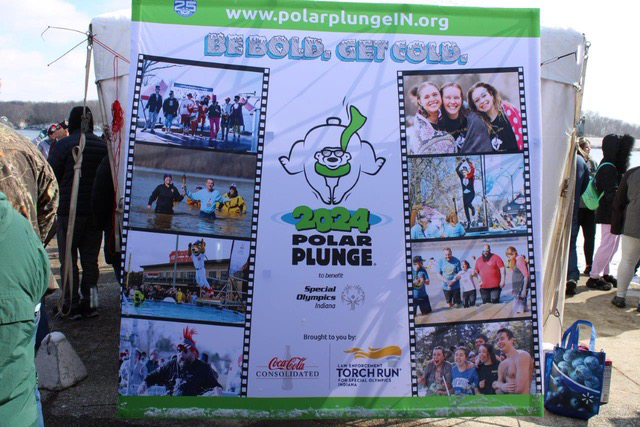
 Washington Co. Chillers
Washington Co. Chillers
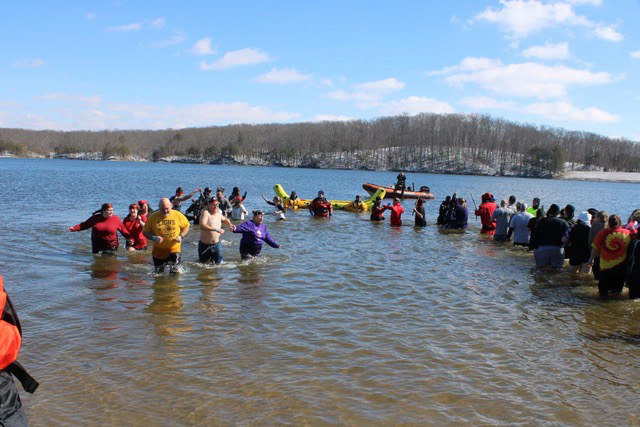
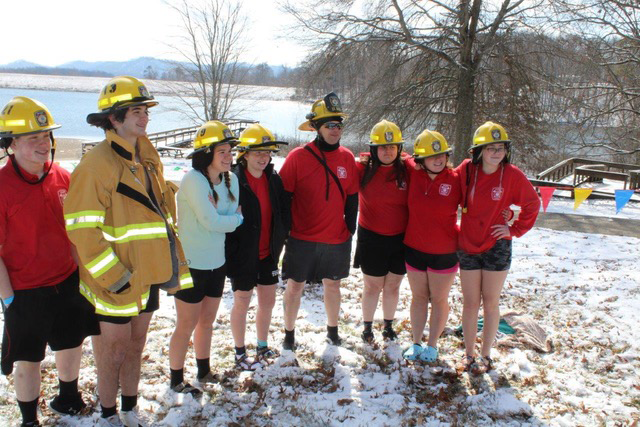 Group from Prosser.
Group from Prosser.
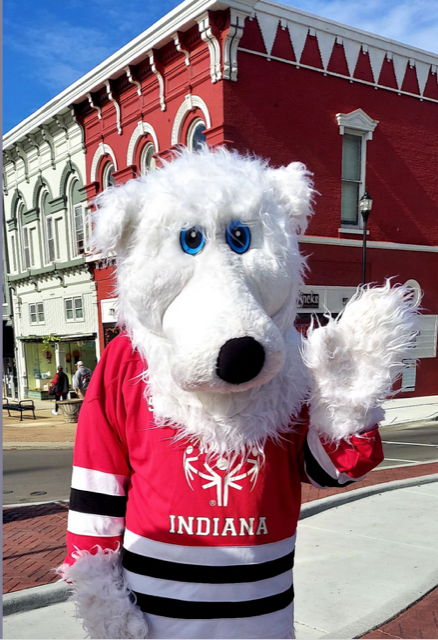

By Becky Killian, Staff Writer
Officials have been asked to spend a portion of the county’s invested funds for a new building at the fairgrounds.
Commissioner Todd Ewen asked for an amount possibly up to $300,000 at the Washington County Council meeting on Monday, Feb. 3.
An engineer estimated that the cost to replace the 4-H building is $1.4 million. That estimate was included in a project proposal submitted to the state through Our Southern Indiana Regional Development Authority. The project was approved but it requires a local investment. Ewen estimated the county’s matching funds could range from $250,000 to $300,000.
The funds Ewen referred to are invested in a certificate of deposit totaling $1.25 million. Ewen said the county could reinvest the $1 million and use the rest as matching project funds.
“It’s a worthwhile project,” Ewen said. “It’s one that’s going to benefit the community.”
Ewen said the existing 4-H building is in such poor condition that it isn’t salvageable. The proposed plan calls for the demolition of that building and the construction of a new building on the same footprint.
The project would begin after this year’s fair and is expected to be completed in time for the 2026 fair.
Most of the new building’s space will be used as a meeting area and for 4-H exhibits. The remaining portion will be used as office space for the Washington County Purdue Extension Office.
Ewen said the extension office hosts meetings and events throughout the year, and additional space is needed.
The extension office is currently located in the Washington County Government Center located on Martinsburg Road.
Ewen has been a longtime advocate for the extension office and the 4-H program. During the council meeting, Ewen said the 4-H program instills values, including a work ethic, in children that eventually makes them effective members of the county’s workforce.
The council, in keeping with its practice of not making monetary decisions at the same meeting at which the proposal is made, will discuss and possibly decide on the funding during its next regular meeting on Monday, March 3.
In other business, the council approved a new policy it will use when considering tax abatement requests. The policy is meant only to be a guideline, and all tax abatement decisions remain with the council.

The Indiana State Department of Agriculture, The Nature Conservancy, Indiana Agriculture Nutrient Alliance and the United States Department of Agriculture’s (USDA) Risk Management Agency have joined forces to implement the Cover Crop Premium Discount Program for the fifth year in a row.
This program will reward farmers who plant cover crops by providing a reduced premium on their crop insurance. The discount program was designed to promote planting additional acres of cover crops that are not covered by other state or federal incentives. This program is eligible for 50 out of the 92 counties in Indiana.
"Our agency is thrilled that we were able to roll out this program again thanks to the support from USDA and The Nature Conservancy," said Don Lamb, director of the Indiana State Department of Agriculture. "Last year this program was available to 26 counties and we have nearly doubled that for 2025. Cover Crops provide numerous benefits for soil health, but they come at a cost, so this program is key to ensuring farmers have the support necessary to build up their soil health."
Over the last year, this program has had great success with 101 farmers participating, resulting in more than 30,000 acres of cover crops on Indiana farmland in the watershed.
This program will provide farmers with a unique opportunity to receive financial incentives for implementing cover crops on their operation. Farmers who plant cover crops on owned or rented acres will receive a $5 per acre crop insurance premium discount. Farmers who planted cover crops in the fall of 2024 are eligible to apply.
Qualifying counties in the project area include Bartholomew, Boone, Brown, Clark, Crawford, Daviess, Dearborn, Decatur, Delaware, Dubois, Fayette, Floyd, Franklin, Gibson, Greene, Hamilton, Hancock, Harrison, Hendricks, Henry, Jackson, Jefferson, Jennings, Johnson, Knox, Lawrence, Madison, Marion, Martin, Monroe, Morgan, Ohio, Orange, Owen, Perry, Pike, Posey, Randolph, Ripley, Rush, Scott, Shelby, Spencer, Switzerland, Tipton, Union, Vanderburgh, Warrick, Washington, Wayne.
Cover cropping has many benefits including increased organic matter, improved soil biology as well as better water infiltration and water-holding capacity. This practice also prevents nutrients and sediment from running off the farm, keeping them out of nearby waterbodies and streams. Hoosier farmers planted a record 1.7 million acres of living covers in 2023 and, apart from corn and soybeans, are planted on more acres than any other commodity crop in Indiana.
Seeding of cover crops must follow best agronomic practices in terms of appropriate seeding rates, seed mixes and seeding dates to ensure objectives of the cover crop are being met. To ensure the practice provides the best results, termination must be completed in the spring. Enrollment is first come-first served and there is a 750 acre cap. This program is also only available to fields not enrolled in other conservation programs.
Larry Clemens, the Indiana State Director of The Nature Conservancy shared, “we are excited to again support the Cover Crop Premium program and offer an additional option to Indiana farmers that are nationally leading the way in the adoption of soil health practices.” Clemens continued, “the Cover Crop Premium program jumped from 26 Indiana counties last year to 50 this year, giving more farmers flexible solutions to continue and expand the use of cover crops outside of other programs. Cover crops improve soil health, water quality, water holding capacity of soils, and they can sequester carbon, decrease weed pressure and reduce the cost of inputs.”
The program is funded by a Clean Water Indiana grant and support provided to The Nature Conservancy by the Cummins Foundation and CenterPoint Foundation.
Applications are due March 15, 2025, or when available funds are exhausted. Learn more and apply here or visit isda.in.gov.

By Becky Killian, Staff Writer
A county resident called for the dissolution of the county’s Plan Commission and Board of Zoning Appeals and a commissioner moved to do just that – only to have the motion fail for lack of a second.
The county resident, Rhonda Greene, spoke to the Washington County Board of Commissioners during its Tuesday, Feb. 4 meeting.
Only two of the three commissioners were present at the meeting. Commissioner Todd Ewen said that Commissioner Phillip Marshall was absent due to illness.
The meeting room at the courthouse was filled with more than 30 people. Those attending included city and county police who have been more visible at county meetings since the contentious issue of a revised comprehensive plan that includes zoning restrictions has sparked one known threat of violence and the arrest of three people.
Reading from a prepared statement, Greene said the two boards are “illegal” because not all members are qualified to serve based on state law.
She asked that the revised Comprehensive Plan, which hasn’t been adopted yet, be used as an “advisory document” so the county qualifies for grants that require a plan to be in place. Also, she asked that the plan be amended to include designated areas for sexually oriented businesses.
Greene said she started an online petition for her cause that has garnered more than 653 signatures and that she is in the process of obtaining a physical petition.
“This is an outcry from the community,” Greene said. “Please don’t ignore it.”
Her comments met with scattered applause from the audience.
Ewen said the boards are legal.
Commissioner Tony Cardwell Jr. made the motion to dissolve the Planning and Zoning Board. Ewen didn’t second that motion, so it failed.

Every two seconds someone in the U.S. needs blood. It is essential for surgeries, cancer treatment, chronic illnesses, and traumatic injuries. Whether a patient receives whole blood, red cells, platelets or plasma, this lifesaving care starts with one person making a generous donation.
PThere are several blood drives planned in Washington County through February.
Dates and locations include:
Friday, Feb. 14
Washington County Family YMCA
1709 North Shelby Street
Salem
1 p.m.-5 p.m.
Monday, Feb. 17
First Baptist Church of Salem
205 North High Street
Salem
1 p.m.-6 p.m.
Monday, Feb. 24
Southern Hills Church
1645 Hwy. 135
Salem
1 p.m.-6 p.m.
Every two seconds someone in the U.S. needs blood. It is essential for surgeries, cancer treatment, chronic illnesses, and traumatic injuries. Whether a patient receives whole blood, red cells, platelets or plasma, this lifesaving care starts with one person making a generous donation.
Blood Supply Statistics
The Red Cross provides about 40% of our nation’s blood and blood components, all from generous volunteer donors. But supply can’t always meet demand because only about 3% of age-eligible people donate blood yearly. Each new donor helps us meet patient needs.
• Each year, an estimated 6.8 million people in the U.S. donate blood.
• 13.6 million units of whole blood and red blood cells are collected in the U.S. in a year.
• About 45% of people in the U.S. have Group O (positive or negative) blood; the proportion is higher among Hispanics (57%) and African Americans (51%).
• Type O negative red cells can be given to patients of all blood types. Because only 7% of people in the U.S. are type O negative, it’s always in great demand and often in short supply.
Type AB plasma can be transfused to patients of all blood types. Since only 4% of people in the U.S. have type AB blood, this plasma is usually in short supply.
• Red blood cells must be used within 42 days (or less).
• Platelets must be used within just 5 days.
Facts About Blood Needs
• Every 2 seconds someone in the U.S. needs blood and or platelets.
• Approximately 29,000 units of red blood cells are needed every day in the U. S.
• Nearly 5,000 units of platelets and 6.500 units of plasma are needed daily in the U.S.
• Nearly 16 million blood components are transfused each year in the U.S.
• Sickle cell disease affects 90,000 to 100,000 people in the U.S. About 1,000 babies are born with the disease each year. Sickle cell patients can require blood transfusions throughout their lives.
• The average red blood cell transfusion is approximately 3 units.
• A single car accident victim can require as many as 100 units of blood.
• Blood and platelets cannot be manufactured; they can only come from volunteer donors.
• The blood type most often requested by hospitals is type O.
• One donation can help save more than one life.
• According to the American Cancer Society, more than 1.9 million people are expected to be diagnosed with cancer in 2023. Many of them will need blood, sometimes daily, during their chemotherapy treatment.
SalemLeader.com
Leader Publishing Company of Salem, Inc.
P.O. Box 506
117-119 East Walnut Street
Salem, Indiana. 47167
Phone: 812-883-3281 | Fax: 812-883-4446
Business Hours:
Mondays through Fridays, 9:00am - 5:00pm
News:
news@salemleader.com
Office:
office@salemleader.com
Publisher:
publisher@salemleader.com
Business
- More Business News
- Go To Guide
- Business Directory
- Auctions
Education
- More Education News
Opinion
- Editorials
- Letters to the Editor
- Columns
- Unsung Heroes
- Days Gone By
- In the Garden
- Guest Columns
- Reader's Poll
- Salem Leader Forum
- Questions and Answers
Church
- Bible Aerobics
- Church News
- Church Directory





